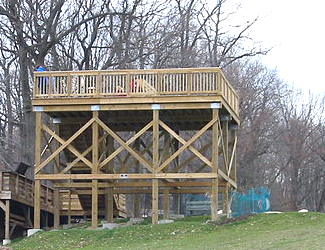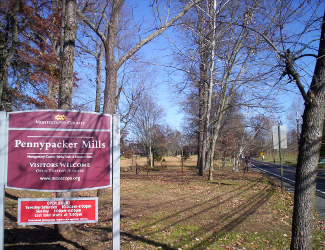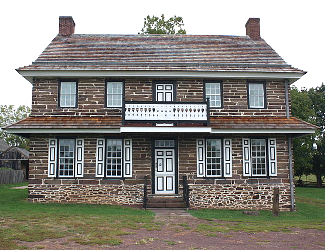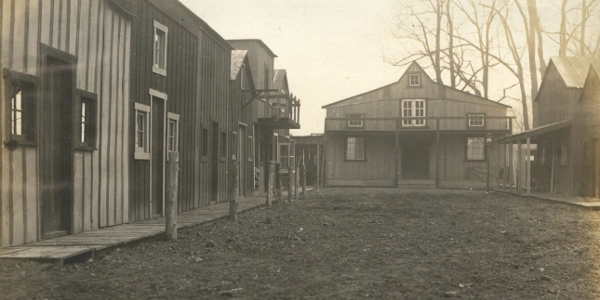
Photo above: One of the headquarters used by Continental Army commanders during the Whitemarsh Encampment and Battle of Whitemarsh, Hope Lodge. Courtesy Wikipedia Commons.
America's Best History Spotlight
On this page we're going to Spotlight the lesser known historic sites and attractions that dot the history landscape across the USA and are worth a visit if you're in their area. And while they may be lesser known, some are very unique, and will be that rare find. You'll be, at times, on the ground floor, or maybe even know something others don't. It'll be fun. Visit them.

Battle of Whitemarsh, Pennsylvania
An encampment, a battle, although if you asked a history buff about the Philadelphia Campaign of 1777 pitting the Continental Army of George Washington against Howe's British Soldiers, you'd be hard pressed to get much, if any, information about it. You see, there was a final battle on December 5-8 between those two forces in General Howe's last attempt before winter to do away with Washington's Army. But Washington, after losses at Brandywine, the Battle of the Clouds, Paoli, and Germantown, had fortified well on the hills of today's Fort Washington State Park. So well, that Howe would give up and return to his new confines in Philadelphia. A few days later, Washington would leave this camp and head to that storied encampment at Valley Forge. Photo above: View of the British Positions, Battle of White Marsh, 1777, Johann Martin Will. Courtesy Library of Congress via Wikipedia Commons.
Info, What's There Now, History Nearby

Encampment and Battle of Whitemarsh
Despite the fact that the Battle of Whitemarsh and its encampment have receded into history, overshadowed by its more famous Valley Forge cousin, a trip for the history buff from the more well known is worth the time. There's Hope Lodge, Mather Mill, Fort Washington Park, and a driving tour put together by a student group. The battle was essentially a series of several skirmishes won by the British. What you will notice very easily while driving through Fort Washington park, is the height of the ridges and the good reason why General Howe decided it wouldn't be easy to roust Washington's forces from them in a general battle, so he left. It's also interesting to climb onto the observation tower. It's near, but not exactly where some of the redoubts were located. And although today it's a site mostly used to watch hawks, peer into the valley toward Philadelphia. Washington chose this location well, and you can even wonder why he bothered to change sites to Valley Forge after the battle. Yes, Valley Forge had the river and easier transportation of supplies, if you wanted to know one of the main reasons.
Photo above: Hope Lodge, 1937. American Historic Buildings Survey. Courtesy Library of Congress via Wikipedia Commons.
Where Is It
Hope Lodge and the Fort Washington encampment site is located fifteen miles from Valley Forge National Historical Park. There's several ways to get there, easy, but longer Route 202 north and Route 73 east. The Schuylkill Expressway to E-276, then onto Plymouth Road, Butler Pike, and Militia Hill Road. The address of the park is 500 Bethlehem Pike, Fort Washington, PA 19034. The address of Hope Lodge is 553 S. Bethlehem Pike, Fort Washington, PA 19034.
Minute Walk in History
Battle of Whitemarsh
This Minute Walk in History recounts the small, but important Battle of Whitemarsh in the Revolutionary War. After the Continental Army had lost the Battle of Germantown in an effort to push the British out of Philadelphia, they camped west of the city at Pennypacker Mills, the Peter Wentz Farmstead, and finally the Whitemarsh encampment. British General Howe decided to make one more push before winter to destroy Washington's Army. Walk with us through the three encampments and listen to George Washington's words, plus those of Lt. James McMichael.
What is There Now
Hope Lodge, Mather Mill, the hills of Fort Washington State Park where the militia and redoubts were located (no longer there), an observation platform that gives you a sense of what Washington saw looking toward Howe's troops in Philadelphia, one explanation marker (hard to believe there's not more), and a driving tour put together very well by the students of the Honors Class of the Philadelphia Montgomery Christian Academy. Emlen House, which was General Washington's headquarters, still exists, but is private property and has been modernized.
How Much to Visit
Fort Washington State Park is free. Hope Lodge, open for tours only on the 3rd Sunday of each month from April to October, costs $5 per adult. You can visit the grounds daily. Mather Mill, between the lodge and park, is currently not open for tours due to structural problems.
Hours Open
Dawn to dusk for the park and grounds. Hope Lodge, 3rd Sunday of Month from April to October, some later dates, from 12:30 to 4:00 p.m.
Websites
Hope Lodge
Fort Washington State Park
Battle of Whitemarsh Driving Tour
History Nearby
Well, it's obvious that the main historic sites in the area are Philadelphia and Valley Forge National Historical Park. If you're coming down Bethlehem Pike, you're also not far from the National Museum of Industrial History in Bethlehem and other Bethlehem area historic sites..
Photos, History, and More Spotlights

History of Encampment and Battle
Washington's troops had been defeated at almost every turn in the Philadelphia Campaign. His mistake of allowing Howe to reach Philadelphia unopposed when camped at Pottsgrove due to a feignt west by the British had caused his attempt to regain the city in the Battle of Germantown. But Washington lost. After the subsequent loss of Fort Mifflin and the Delaware River, the Continential Army needed to hunker down in a fortified position. From November 2 to December 11, he chose the Whitemarsh Hills along the Wissahicken Creek and Sandy Run, close enough to the city, sixteen miles, to monitor British movements and plan the next attack.
After the British had fought off the valiant effort of the americans to hold onto Fort Mifflin on November 15, General Sir William Howe contemplated a final move to finish off Washington before winter. Washington was being pressured to attack Philadelphia and Howe as well, holding a council of war on November 24. An attack was voted down 11-4. But Howe would give him no choice, he decided to march his British army of 10,000 men out to the White Marsh, or Edge Hill, on December 4, led by General Cornwallis. The next day, just after midnight, Cornwallis skirmished with the Continental Army near Three Mile Run. The attack continued hours later with the British winning the day. Two days later, the British would attack again, gaining victory and forcing the Pennsylvania militia back toward camp.
On December 8, Howe checked the American positions again, and despite victory in the two major skirmishes of the days before, decided that the position at Fort Washington was too strong to engage in a general assault. He retreated back to Philadelphia. Three days later Washington marched his men to Valley Forge, reaching that camp on December 19.
Image above: Observation platform near site of militia redoubts at Fort Washington State Park. Courtesy Wikipedia Commons.

How They Got There
So here goes an attempt to do the Philadelphia Campaign in lightning round fashion. General Howe sailed from New York City and arrived at the northern end of the Chesapeake Bay in late August with 15,000 troops, intending to attack Philadelphia from the south. The Battle of Brandywine occurred September 11 (a George Washington loss) followed by the the Battle of the Clouds on September 16 and Paoli Massacre of September 20. Washington, thinking that the British were heading toward his iron forges to the west, headed west, then east, eventually camping at Pottsgrove after taking a feignt by the British and allowing them to capture Philadelphia on September 26.
Washington, after learning of the capture, began preparations for an attack. He moved his troops east down Skippack Pike toward the northern edge of Philadelphia, camping at Pennypacker Mills from September 26-29, then moving to the grounds of the Jacob Wentz Farmstead, October 2-4, to plan the Battle of Germantown. He would come back to both locations after the battle of Germantown, another loss on October 4; at the mill from October 4-8 and at the farmstead from October 16-20.
Photo above: Mather Mill on site of the encampment, 1930. Historic American Buildings Survey. Courtesy Library of Congress.
Washington's Camps of the Philadelphia Campaign

Photo above: Washington's Headquarters, September 23-26, 1777, in the Antes House at Camp Pottsgrove. Washington was camping here while the British went into Philadelphia unopposed in late September 1777.

Photo above: Washington's troops camped at Pennypacker Mills, home to Governor Pennypacker in the early 1900's. The Continental Army camped there twice during the second half of the Philadephia Campaign, both prior to and after the battle of Germantown. The home and grounds are open for visitation.

Photo above: Peter Wentz Farmstead. The farm was the second of the camps on the way to the Battle of Germantown, located midway between Camp Pottsgrove and the northern part of Philadelphia. The farm is open for visitation. Courtesy Wikipedia Commons.
About
America's Best History where we take a look at the timeline of American History and the historic sites and national parks that hold that history within their lands.
Photos courtesy of the Library of Congress, National Archives, National Park Service, americasbesthistory.com and its licensors.
- Contact Us
- About
- © 2025 Americasbesthistory.com.
Template by w3layouts.



